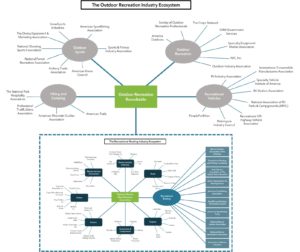The public concern about energy affordability, the environment, and global conflict has required America to create a pathway to address and solve the persistent hard times we face. Throughout its history, the U.S. scientists, researchers, and private companies routinely demonstrated that when faced with stiff challenges, this country is capable of overcoming adversity and achieving lofty and heroic breakthroughs. Realistically, we know there is a unfortunate political divide, record high energy prices, and a strong desire to reduce the carbon footprint. It’s time to reimagine how strategic partnerships between industry associations and their member companies solve the issue of reducing the carbon footprint. As we have seen, no other solution can make as great an impact.
Strategic partnerships between industries and their trade associations already help deliver unified advocacy strategies and they convene industries to design and deliver solutions to solve problems.
- The Recreational Boating Industry continually seeks to gain consumer acceptance and to grow the industry across all of its markets. In order to achieve to grow consistently, the Industry relies upon its strategic partner, the National Marine Manufacturers Association (NMMA) to make sure policies are put in place to help the Industry thrive. For example, there are always regulatory efforts that impede the industry’s progress. NMMA built a durable foundation of relationships and data to serve as a potent advocacy juggernaut.
- NMMA built an ecosystem of suppliers, retailers, and manufacturers capable of pushing back against efforts to ban watercraft or restrict access to fisheries and waterways. Later, they expanded the Recreational Boating Ecosystem with the creation of The Outdoor Recreation Roundtable (ORR). The Roundtable bills itself as “America’s leading coalition of outdoor recreation trade associations and organizations working to promote the growth of the outdoor recreation economy and outdoor recreation activities.” In fact, it is a great web of interlocking strategic partnerships. They believed (and now know) that what is good for outdoor recreation is good for boating and fishing. This scale helps the entire Outdoor Recreation Industry insure that favorable policies are implemented at all levels of government.

- Today the U.S. Department of Commerce’s Bureau of Economic Analysis (BEA) recognizes the ORR as a vital contributor to U.S. gross domestic product (GDP). This recognition helps outdoor recreation and recreational boating make strong cases to elected officials and regulators that might otherwise impede usage of their products. Former National Marine Manufacturers (NMMA) President Thom Dammrich credits the ORR as the linchpin that helped achieve the BEA’s recognition of outdoor recreation’s as an important economic driver.
The most fertile ground for building strategic partnerships within industries is through trade associations. Strategic partnerships through trade associations are among the most reliable and influential resources at our disposal. They can serve as neutral integrators, collect information on points of opportunity throughout the Industry supply chains. From there, they develop policy solutions, implement advocacy strategies, and deliver roadmaps to shareholders and the public which incorporate a in a manageable timeframe. It is essential that every Industry utilizes this approach to reduce carbon missions. It is efficient, effective, and results oriented.
The Asphalt Pavement Industry is a foundational staple of the economy and an example of how a strategic partnership between and Industry and a Trade Association can work together to manage and cleaner energy footprint. Asphalt Pavement employs over 750,000 workers in direct and related Industries, including:
- 343,120 people in the construction of highway, streets, runways, roads, and bridges
- 59,860 heavy construction equipment operators
- 243,840 people in civil, environmental, and geotechnical engineering
- 111,470 in the refining sector
The Industry is represented by the National Asphalt Pavement Association (NAPA). This is the only national association representing the interests of asphalt mixture producers.
Jim Mitchell, CEO of Superior Paving Corporation and 2022 NAPA Chairman, says that “What NAPA does, what it has always done, is to be collaborative and forward-thinking and practical in everything they do.” He goes on to say that “We have the lion’s share of the Industry represented by our association . . . most importantly, by talent. We have some amazing, amazing people among our membership.”
The Industry views NAPA, their strategic partner Trade Association, as the Industry and an exceedingly important partner on many fronts. The Industry insists on a high-quality standard in all of its project. It emphasizes the value it delivers to its customers, and together they are determined to deliver enhanced mobility and a thriving and sustainable transportation network throughout the United States.
NAPA is led by Audrey Copeland, Ph.D., P.E., president & CEO. She and her highly skilled team operate with shared Industry values that include:
- Trust
- Expertise
- Sustainability (doing the right thing)
- Community focus
NAPA’s expertise, partnership, and superior consensus building expertise helps position and elevate important discussions. Victories include improving worker safety, environmental product declarations that measure the environmental impacts of asphalt mixtures and advancing pavement technologies.
With a keen eye towards the future, the Industry and NAPA are collaborating on a member driven initiative to reach Net Zero Carbon Emissions. At its 2022 Annual meeting, NAPA declared that the asphalt pavement Industry is setting goals in part with the Paris Agreement and the findings of the Intergovernmental Panel on Climate Change. This member driven effort is supported by expert driven research captured in an ambitious roadmap, “The Road Forward: A Vision for Net Zero Carbon Emissions for the Asphalt Pavement Industry”, is a strategic partnership initiative. Working collaboratively with its members, staff, and partners, it plans to achieve an ambitious net zero carbon emissions by 2050.
Over the last 40 years and eight Presidencies, there is no established and consistent energy and environmental policy. The Asphalt Pavement Industry Ecosystem led by the National Asphalt Pavement Association is reimagining the strategic partnership with their member companies to address the issue of reducing the carbon footprint.
Transforming to a clean energy economy requires capacity, expertise, wisdom, insights, and the scale necessary to build practical and durable energy policy and viable strategies. Success also requires thoughtful roadmaps, timelines and Industry expertise. The Industry and Trade Association Strategic Partner approach is proactive, forward looking, and can help every Industry move down a pathway to reduce their carbon footprint. It’s time to reimagine how strategic partnerships between industry associations and their member companies can achieve a more favorable environmental outcome for the U.S.
Book Dan Varroney as a speaker for your meeting, conference or group and learn how to tap into the potential of strategic partnerships with industry associations from the author of the groundbreaking book, Reimagining Industry Growth.





